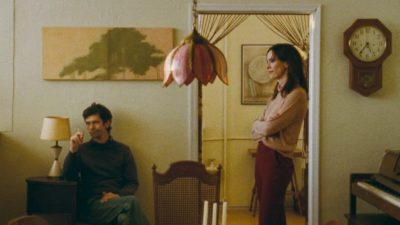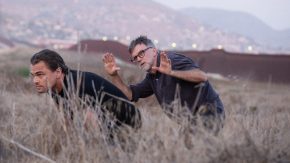Secundino Hernández, who lives and works in Madrid, started his international gallery-déput with his eponymous exhibitions following a Residency at Krinzinger Projekte in 2007. Just five years later, he made his breakthrough in the international art scene by selling six works to the Rubell Family Collection at a presentation at ARCO Madrid 2012. Today Secundino Hernández, with his large-format paintings, is one of the international artists who shapes the contemporary art market. His frenetic oil, gouache and acrylic paintings refer to action painting, the old masters, especially Spanish ancestors like El Greco and Velázquez but also to the paintings by Cy Twombly, Francis Picabia and Joan Miró.
Secundino Hernández’ exhibition One More Time Is Good Enough at the Galerie Krinzinger presents three series of works from the past three years. Here we will see a broad spectrum of his abstract painting, which can be described as opulent, colorful, expressionist but also as monochrome and ascetically minimalist.
Venue: Galerie Krinzinger, Seilerstätte 16, 1010 Vienna
Duration: May 20 – August, 1, 2020
Opening houre: Tue – Fri 12am – 6pm, Sat 11am – 4pm
Free admission
In his screen prints on brown cardboard, made in 2020, informal formal complexes float on the surface where the creative process work unfolds, marking the artist’s graphic action. These traces that condense to form compact forms and signs are roughly placed, recalling the structures of a wood cut when the artist bruises the unwieldy material, the wood with gouge, knife or a milling machine. Similar to the white-line cut in a Relief printing process in woodcut, the treated spots remain unprinted, not taking on any ink, in the flat printing applied here, and the brown cardboard, that is, the surface of the picture, absorbs these spots. This way the negative spots become abstract marks and signs within the pictorial composition. The techniques used to subtract – the removing, cutting out, erasing, washing off – can often be found in Hernández’s artistic process. And this approach is also part of the two further series presented in the exhibition. As in the screens prints, the black picture ground dominates in the paintings created in 2020. In lieu of the color-neutral negative forms the canvas is now filled with a colorful painterly opulence. Brushstrokes, blobs of paint cover the entire surface of the picture, creating an informal color mosaic of painterly discharges. Their dull glisten recalls sullied precious stones emerging from the black ground. Or it could be that the artist has uncovered these stones from the dim black crust of paint by rinsing the surface.
The third group of works is part of the Wash Paintings, a series the artist already began in 2016. After the process of painting Hernández proceeds to attack the canvas with a heavy- duty pressure washer and rinses its original membrane of the painting. What remains now, remains for posterity. This grand gesture of aggression leads to a purging of the picture. The easel painting is, however, not destroyed, murdered, unlike, by contrast, in the work of his Spanish compatriot Joan Miró who sought to precisely this in his Toiles Brulées of the1970s. Miró set the painting on fire or slit it with a knife. With Hernández, it is more an aquatic skinning, a process of subtraction, from which, in turn, pure painting can then emerge. Just think, by comparison, of Nouveau Realists such as Mimmo Rotella and Raymond Hains who removed the collages of billboard walls and used them to create compositions with a painterly structure. The new Wash Paintings show a purified force, their scaffolding has been uncovered as it were, which is manifest in the graphic network of vertical and diagonal lines. These are not drawn or painted lines, but rather physical-organic ones consisting of sutures. The artist cut the corpus of the canvas into several pieces and then had it finely sewn back together again. What emerges is a prismatic pictorial field, which allows an intricately broken pictorial space to unfold. This space is not one that is derived from reality but rather an abstract, picture-immanent one, something comparable to the broken spatial systems in analytic cubism. But unlike with Picasso, in the case of Hernandez there is no centrally moored pictorial object like a pitcher or figure, around which spatiality is constructed. While Picasso shattered the mirror of reality, Hernandez skins the body of painting by rinsing it, revealing the bones, the inner space of abstract easel painting. Yet this abstract space – structured by graphic configurations – is always bound to the factual nature of painting, its surface. A similar relationship between line/scaffolding and surface /space can be noted in Piet Mondrian’s orthogonal, neo-plasticist compositions as well as in the minimalist grid paintings of Agnes Martin or Brice Marden. Referring to the painterly surface the following principle adopted by Robert Ryman applies: “What makes for the painting is precisely what one sees.” The painting consists simply of materials such as the surface (canvas, paper) and the layer of paint applied to it. Any illusionism is suppressed to the benefit of f/actual two-dimensionality and painterly make.
For purposes of neutralizing Ryman had limited himself to the non-color white which he carefully applied with the brush to the canvas or a different surface forming the square ground of the painting. This Rymanian aspect of painting is also visible in Hernandez’ recent white Wash Paintings. In some spots the untreated canvas appears; here the painting resembles masonry on which the plaster has loosened. The strictly minimalistic is relativized by what appears ruinous. One might also recall Jean Dubuffet’s wall paintings. The recent dark Wash Paintings with their shades of gray, pigeon blue and black constitute the nocturnal alter ego of these light white paintings. They develop a black romantic atmosphere like a wavering shroud that leads us into a transcendental world. Like the white paintings they are vertical in orientation, structured by the strips of canvas that have been stitched together in a predominantly perpendicular fashion. These paintings are based on a dualist conception of destruction and construction. Here the artist renounces the purely creative signature in the form of a charged gesture – manifest in abstract expressionism as a loaded brushstroke. Reaching for a heavy-duty pressure washer he opts for a destructive tool, one that works on the basis of chance, destroys his previously set painterly traces and creates a new painting out of them. Jackson Pollock, too, operated with planned chance in his drip paintings. He let paint drip on the canvas, while he was standing away from it at a certain distance – this, as opposed to brush and pencil that can be used in a much more controlled way with direct contact to the surface.
As early as 2007 Secundino Hernández showed for the first time with the Galerie Krinzinger when he was invited to take part in the Artist in Residence program in Vienna and presented his paintings in the spaces of Krinzinger Projekte. Unlike his more recent abstract work, his paintings at that time were strongly figurative but not in the classical sense, that is, portraits or realistic depictions of individuals. Rather, they showed figurative shorthand such as hands, feet and heads that sprung up out of the surface of informal painting. Grotesque anomalies arose, a pastiche of surrealist écriture automatique, caricature-like cadavre exquis. Around 2010 this hybrid figurative-abstract system began to fizzle out, giving way to a more abstract calligraphic and gestural circulating and floating over the surface of a picture. Here drawing and painting merged: graphic shorthand, scrawls with blobs of paint and brush strokes. Altogether they produced an exuberant dynamic floating in the pictorial space. In some instances one could still find lingering figurative rudiments, comic-like remainders. Glistening traces of black, looking as if they were drawn with a felt-tip pen, sitting literally on the surface of the picture, while the finely drawn lines, blurbs of paint and brushstrokes burst into the surrounding space. This collection of innumerous traces and formal complexes resemble a cosmic explosion in galactic space. Painting is freed from the force of gravity, no longer bound to the horizon of any landscape. Yet there is an exception – a larger series of works from 2012/13 where the artist still integrated strictly horizontal strips of color, lending the paintings a landscape-like dimension. One of these cosmic-dynamic compositions of pictorial space was presented in the 2017 exhibition Abstract Painting Now! at the Kunsthalle Krems which presented an overview of the current international scene of abstract art. The broad spectrum reflected both minimalist constructive and ornamental, gestural as well as process-oriented positions. The exhibition covered the 1970s, beginning with Gerhard Richter and Sigmar Polke and leading up to the generation of Katharina Grosse and Secundino Hernández. One year before this I had seen a painting by this Spanish artist for the first time. At the viennacontemporary 2016 the Galerie Krinzinger showed a opaque-gray painting with traces of art informel. I then immersed myself in Secundino Hernández’s universe of painting, which is best described as a dazzling kaleidoscope of abstract art: graphic-painterly, impasto-minimal, spatial-planar, light-dark, skin and bones, destruction and construction, chance and control, emotional-sensual and cool-minimal. (Text: Florian Steininger, Director, Kunsthalle Krems)
Secundino Hernández (born. 1975 in Madrid) studied at the Universidad Complutense in Madrid. In the last years his works were exhibited in numerous museums and art institutions. Selection of solo exhibitions: Meadows Museum at the Southern Methodist University in Dallas, Texas, (2020), Taidehalli Helsinki, (2018), CAC – Centro de Arte Contemporáneo de Málaga (2018), YUZ Museum, Shanghai (2015), The Miettinen Collection, Maison Louis Carré, Bazoches-sur-Guyonne (2014), Rubell Family Collection / Contemporary Arts Foundation, Miami (2013); Selection of group exhibitions: Mirat, Madrid, Spain (2019); Taguchi Art Collection, Japan (2017), Kunsthalle Krems (2017), Royal Academy of the Arts, London (2017), Museo de Arte Contemporáneo Español, Valladolid (2013); Künstlerhaus Bethanien, Berlin (2012), Art Center Los Angeles, Los Angeles (2011), Roger Raveel Museum, Machelen (2010); Secundino Hernández’s works are part of important institutional and private collections for instance at the Museo Patio Herreriano, Valladolid, in the Helga de Alvear-Foundation, the Rubell Family Collection, Miami in the Kunstdepot Göschenen and the Art Gallery of Ontario; Selection of awards: Generación 2007 de Caja Madrid (first prize); Generación 2004 de Caja Madrid; Premio Joven 2003, Fundación General der Universidad Complutense de Madrid; Generación 2002 de Caja, Madrid (recognition award); Solo exhibitions at Galerie Krinzinger: 2015 Today, 2014 Four Season: Between Winter and Spring and 2010 Indigenismo; Solo exhibitions at Krinzinger Projekte: 2007 Secundino Hernández (Artist in Residence).
If you not have a face mask yourself, the gallery will provide one on site.
Text: Galerie Krinzinger

























Comments